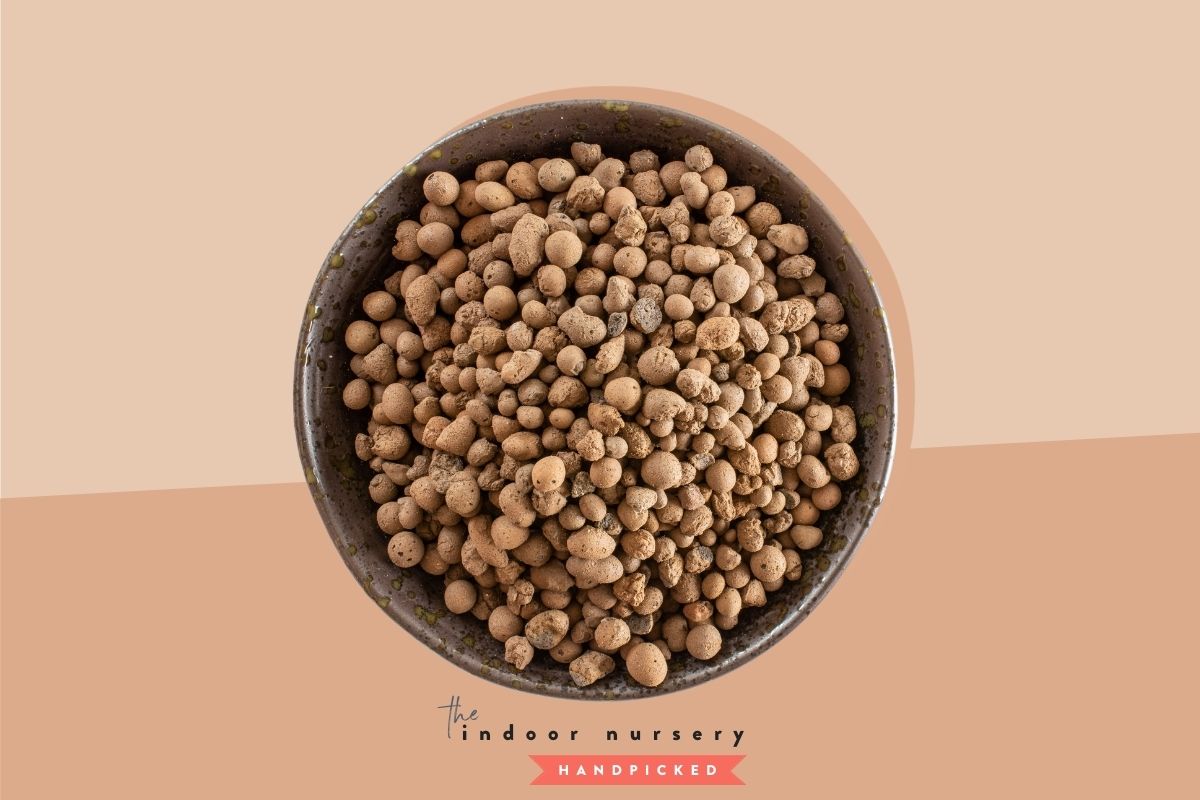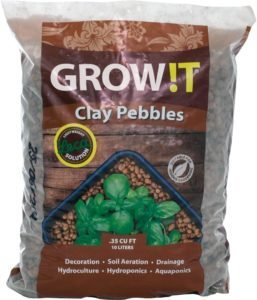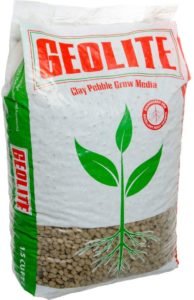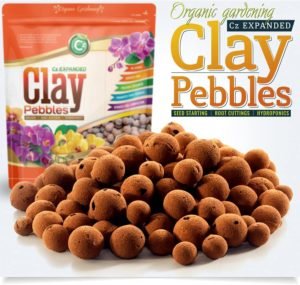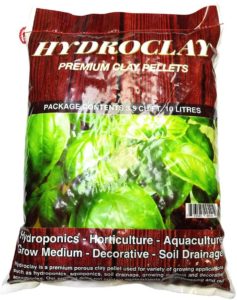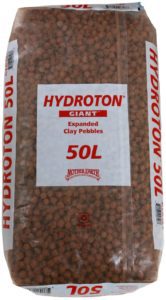🧪 Our review process
Our testing team independently researches, tests, and recommends the best products to help keep your houseplants absolutely thriving. Learn more about our testing and review process here.
LECA balls are all the rage these days and for good reason. This growing medium is a clean, low-maintenance alternative to growing indoor plants in potting mixed with traditional methods. It used to be that only specialty hydroponics growers knew what to do with these little expanded clay pebbles, but today, LECA is widely loved by houseplant fanatics everywhere.
Clay pebbles are an excellent growing medium for many indoor plants, especially in diy hydroponic systems. LECA provides better drainage, increased aeration, and greater protection against mold growth and pests than most potting mixes out there.
The water-retaining qualities of these powerful little pebbles keeps your plants hydrated, as long as you top up! Learn how to use leca for your plants, and grow plants without soil using our top LECA ball recommendations.
The best LECA balls for happy indoor plants (without soil!)
1. Best overall LECA balls: GROW!T GMC Clay Pebbles
Key specs: 10-40 liter bags available | 1.4 liters per pound | pebbles of all shapes and sizes
Our all-around top pick for clay balls is the Grow!t pebbles. Grow!t gardening products are produced by Plant!t, a reputable brand that started out making hydroponics systems, so they know all about the specific needs of plants grown in soil alternatives!
These 100% clay balls from the UK range in size and shape and are red to dark brown in color. Gardeners love the water retention ability of these clay balls, and we do too! They’re suitable for almost any plant suited to a soilless growing medium.
Pros
- Clay fired for strong structural integrity that prevents pebble breakage and compaction over time
- Made from 100% natural clay, providing good drainage and aeration to roots
- Suitable for use in hydroponics systems, including flood and drain, multi-pot, and drip feed, as well as conventional use as a soil alternative
Cons
- The rough finish and irregular sizes of these pebbles make it difficult to reuse them
- Some buyers report the pebbles are actually alkaline – for finicky plants, test your pebbles before use
2. Best budget LECA balls: GEOLITE GMGC45L 45L Clay Pebbles
Key specs: 10 liter and 45 liter bags available | | 4 – 16mm pebbles | 1.1 liter per pound
These clay balls from Geolite are a steal, and on top of that? You can buy a 45 liter bag for your big indoor gardening projects. These clay pebbles are grey in color and offer all of the same oxygenation and drainage benefits in a sterile soil-alternative as any other product on this list, with a better price.
The tradeoff is that Geolite doesn’t offer an average pebble size, so expect to find a variety of sizes in your bag, with some that may be so small that fall through your pot’s drainage holes, and others too big to provide proper stability.
Pros
- Super affordable! These clay pebbles are the best deal out there with reviews confirming the quality of the product
- pH neutral and sterile
- Approximately 85% porosity by volume (a measure of the space within the clay pebble structure) ensures excellent root oxygenation and drainage capacity
- Clay originates in Italy and is produced in Iceland
Cons
- Geolite doesn’t list an average pebble size, but the product is reported to have good variation for all types of plants
- Expect some broken clay balls and a rough finish
3. Best for orchids: CZ Garden Organic Expanded Clay Pebbles
Key specs: 2-20 lb bags available | 4-16mm pebbles | 1 liter per pound
If your orchids aren’t blooming like they used to, your soil may be this issue! Switching to LECA with a regular fertilizing routine will provide all of the nutrients your orchid needs in an elegant medium that you can display beautifully in a glass planter.
These clay pebbles from CZ Garden range in size from 4-16mm, which suit them well to stabilizing thick orchid roots – the size variation means the pebbles will fit snugly into all of the nooks and spaces of your plant’s root structure, creating a stable root ball. Like all LECA clay balls, these are pH neutral and inert, making them a perfect base for your orchid fertilizer.
Pros
- The clay pebble size variation in this product is ideal for nestling into the thick, winding roots that orchids are known for
- Chemically inert, pH neutral and completely sterile
- The clay absorbs water and stores it for slow release when your orchid needs it most, which is perfect for plants that dislike being left with standing water in their tray
- Amazon’s Choice product (highly rated, well-priced and available to ship immediately)
Cons
- Buyers have complained that the advertised product weight is substantially more than what is shipped. CZ Gardens has robust customer service to solve any problems, though!
- This product is advertised as “organic” on Amazon, which is misleading: as an inert product, LECA cannot be certified by the USDA
4. Best uniform LECA balls: Onetour Hydroclay Premium Hydroponics Clay Pellets
Key specs: 10 liter bag available | various size pebbles | 1.8 liters per pound
If uniform size is important to you when choosing clay balls, these clay pebbles from Hydroclay are a good choice. They are consistently oval-shaped, which makes it easier to remove your plant from the medium when repotting, or re-using the LECA.
Like all of our LECA picks, these clay pebbles will provide excellent drainage. With a volume of 1.8 liters per pound, this pick in particular has a high porosity, which means it will store more moisture for your plant’s roots to sip up when they’re thirsty!
Pros
- Consistent oval shaped pebbles are better suited to re-use than other, irregularly-shaped products
- Environmentally-friendly production without contaminants or chemical additives
- Efficiently retains moisture and equally redistributes water and nutrients to your plant’s root mass
Cons
- There is no origin listed for this product
5. Best bulk LECA balls: MOTHER EARTH HGC714123 Hydroton Original Expanded Clay Pebbles
Key specs: 10-50 liter bags available | 15–25 mm clay pebbles | 2.3 liters per pound
If you are already a LECA convert seeking an endless supply of the medium to swap out your soil with or set up indoor soilless gardening beds, we recommend Mother Earth’s Hydroton.
Note that the average clay pebble size is slightly different depending on the bag size you purchase. The 50 L bag contains larger pebbles with an average size of 15-25mm.
These clay balls are produced in Germany, and are highly reviewed all-around. The pebbles are well-shaped for most plants, and are heavy enough not to float when watering (the high volume per pound is due to the larger average size of these clay balls).
Pros
- These big *ss bags are suitable for potting up to 50 small, individually potted plants or a small indoor nursery bed
- Pebbles do not float in water, enabling an easy care routine
- Single-origin clay is mined and processed in Germany for less environmental impact
Cons
- Due to the larger pebble size in the higher volume bags, you may need to mix in small clay pebbles for plants with finer root systems
Our recommendations
| # | Preview | Product | Amazon rating | |
|---|---|---|---|---|
| 1 | best overall LECA balls: GROW!T GMC Clay Pebbles | 4.6 out of 5 | view on amazon | |
| 2 | best budget LECA balls: GEOLITE GMGC45L Clay Pebbles | 4.5 out of 5 | view on amazon | |
| 3 | best LECA for orchids: CZ Garden Organic Expanded Clay Pebbles | 4.5 out of 5 | view on amazon | |
| 4 | best uniform LECA balls: Onetour Hydroclay Premium Hydroponics Clay Pellets | 4.7 out of 5 | view on amazon | |
| 5 | best bulk LECA balls: MOTHER EARTH HGC714123 Hydroton Original Expanded Clay Pebbles | 4.7 out of 5 | view on amazon |
Still unsure which clay balls to choose for your indoor plants?
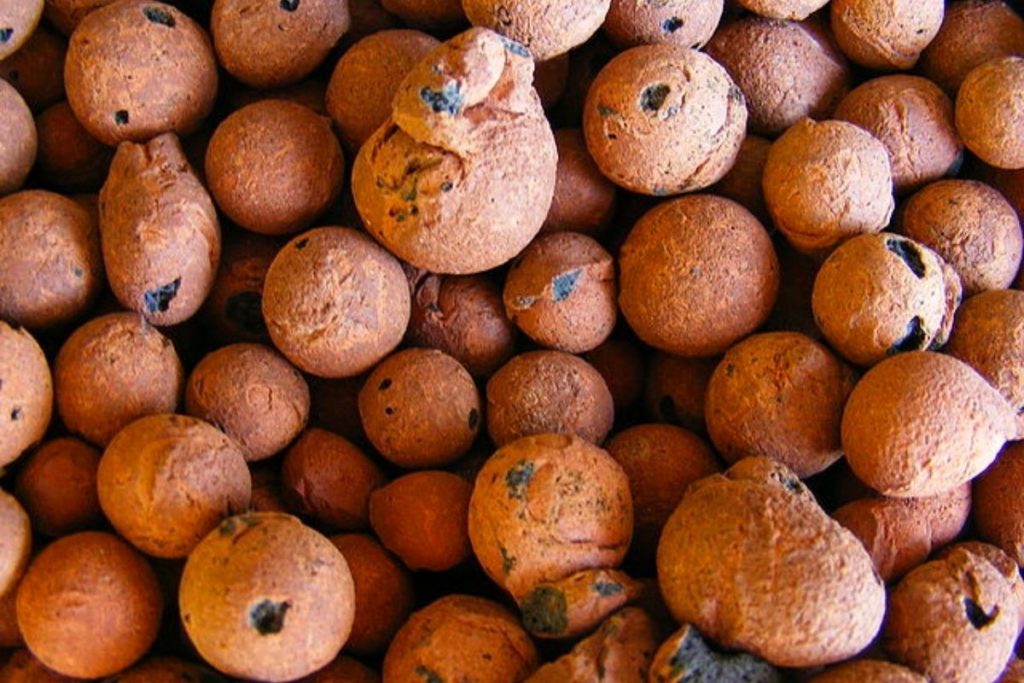
If you’re still unsure which LECA to choose for your indoor plants, we’ve done the research to help you make the best choice. In the following sections, we’ll go over what LECA is and where it comes from, the qualities you should look for when buying LECA, plants that are well-suited to growing in LECA, and more.
What is LECA?
LECA is a growing medium for plants that are becoming more and more popular with indoor gardeners. LECA is an acronym for Lightweight Expanded Clay Aggregate, which is fancy talk for clay pebble balls! You’ll also hear it called hydroton, clay pebbles, and grow rocks.
LECA was initially developed for use in the construction industry, and the firing process was designed to make a lightweight material that was well-suited for structural use in place of traditional bricks. Today, LECA is widely used as a soil additive or replacement in semi-hydroponic systems for its qualities as a well-draining medium that retains moisture and nutrients while minimizing the fungal growth and pest infestations (cursed spider mites!) that come with pre-packaged soil mixes. All of this means it’s easier to maintain your plants in LECA than traditional soil, friends!
True LECA is made from clay, which is mined in clay quarries and then fired at a super high temperature in a rotary kiln (a long, tubular oven that spins while it bakes the clay), which causes the clay to expand and develop thousands of little bubbles, producing a honeycomb structure within the clay pebbles.
How to use LECA for plants
We’ve written all about how to use leca for plants, so read up! If you’d like to experiment with using lightweight expanded clay aggregate as a potting medium for your plants, the process will most likely involve transitioning your plants from soil to LECA. This isn’t too complicated, but you will need to be careful and patient so you don’t damage your plant’s roots in the process.
LECA is a structural growing medium, but it doesn’t contain nutrients – so you’ll also need to find a good semi-hydroponic fertilizer for your plant before you start your project. It’s best to transfer young plants, before they develop dense root structures.
The general process is as follows:
- Prepare your LECA and fertilizer
- Fill your pot ⅓ full with the medium (this prevents plant roots sitting in water and developing root rot)
- Remove your plant from its pot, and clean its roots completely of soil
- Transfer the plant to the pot of LECA
- Fill the pot with the remaining LECA
It’s pretty normal for plants to go through a period of shock after an invasive repotting and medium change like this, so don’t be too worried if your plant droops for a few days.
You can also plant cuttings grown in fresh water directly into LECA, which will generally increase your success rate! The process is nearly the same as above, but in step 3 you simply remove your cutting from its water bath and pop it into the pot. We also recommend adding a small amount of fertilizer to your cutting’s water about 1 week before transfer in order to acclimate the plant to its new environment.
Where LECA comes from
This is a topic of debate on Amazon, where many retailers do not list the origin of the clay or manufacture. After all, if the product is good quality and works well for people’s plants, what’s the big deal? Clay mines are found all over the world, but it’s important to note that the “Country of Origin” listed on Amazon may not be the actual source of clay, but rather where the LECA was manufactured, or even where it is produced.
When investigating the sustainability of your LECA, a good rule of thumb is to choose a product that lists the origin or place of manufacture (many don’t), and to choose products from established brands. Reputable LECA manufacturers will list on their website where the product is produced and manufactured.
Products sold as LECA
The term “LECA” is a generic trademark that originates with the Leca® brand, one of the early innovators in the product’s manufacture and application. Founded in Denmark in the 1930s, Leca® is globally known today as a manufacturer focusing on expanded clay aggregate products in the construction and water cleaning industries.
99% of products sold as “LECA” are not actually produced by the actual Leca® brand (because who knows what expanded clay aggregate is? Not the average buyer!) Many of these LECA look-alikes are made in pretty much the same way as the original, but there are some exceptions.
One major example are ceramsite LECA products. Ceramsite is an artificially-produced clay made from sea dredge waste sludge, and other industrial waste products. Ceramsite products often come in a variety of colors and often perform as well as traditionally sourced expanded clay products. They are often cheaper than LECA products, but the manufacturing process isn’t transparent and origins are rarely offered for ceramsite products, so just keep this in mind when choosing your LECA.
What makes quality LECA
Truth be told, it’s difficult to tell many LECA products apart. The distinguishing characteristics are not always advertised, so it’s always helpful to have a good look at the LECA before buying. When you’re buying on Amazon, check out product reviews for pictures of the LECA you’re interested in, posted by buyers.
Pebble density
The density of your clay pebbles is an important factor in how it will perform as a potting medium. Pebble density is rarely advertised directly for most LECA products, but sometimes brands will offer an average porosity of their product. Porosity is a measure of the empty space within the structure of the clay pebble. A good porosity is anywhere between 60-85%.
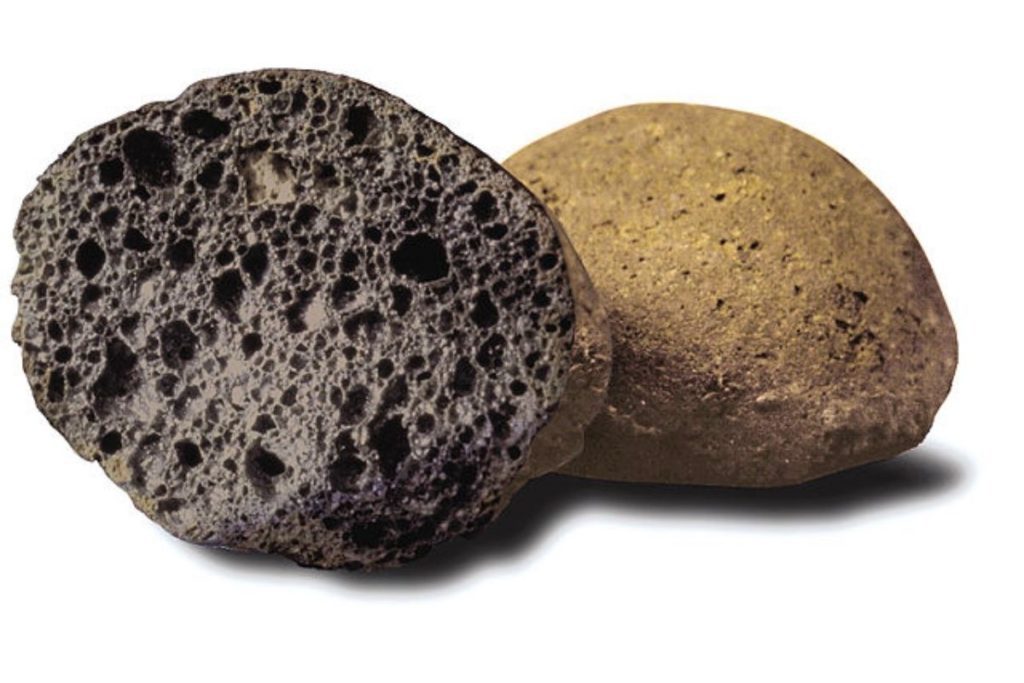
If no density measures are provided, you can estimate it by dividing the volume of the bag (typically listed in Liters) by its weight (often listed in pounds) to get liters per pound. Generally speaking, the lower this number, the more dense (less porous) the LECA is, and the higher this number, the less dense (more porous) the LECA is.
The size of the clay pebbles will also affect the density of your LECA. If two LECA products are completely identical except for the size of the pebbles, the package of smaller pebbles will have a higher package density because there will be less space between the little balls
To get the most for your money, avoid products sold by weight, since this measurement includes the layer of LECA dust sitting at the bottom of the bag, which isn’t usable. You’ll wash it right down the drain when prepping your clay pebbles!
A note on floaters: you may find some reviewers complaining about their LECA floating in water, but this is actually a good sign! It means the product is full of air pockets, as it should be. Typically, floating clay pebbles will increase in density once prepared by boiling and soaking, so this shouldn’t be a problem if you treat them right ☺️
Pebble size and texture
We recommend clay pebbles between 4-8mm in diameter because they hold the most water, according to a study by the American Society for Horticultural Science. If re-using the pebbles is important to you, for example if you’re using them to grow crops in a hydroponic system, aim for consistently sized, round pebbles with a smooth surface.
These are easier to disentangle from plants roots. Irregularly-shaped LECA of varying sizes provides more stability than round clay pebbles though, so if you have a top-heavy plant, look for a product with more size variety.
“Organic” LECA
Let’s be clear, plant friends! LECA is inert, meaning chemically inactive. Not alive. All LECA is “organic” in the sense of chemistry, but like a rock is organic – meaning from the Earth.
Products that claim to be “organic” are falsely advertising based on this distinction, knowing that most people will think “organic” as in certified USDA organic. There is no such thing as organic LECA!
What else you’ll need to grow indoor plants with expanded clay pebbles
There are a few extra supplies you’ll need to start growing plants with clay pellets, or transfer your soil grown plants to LECA clay. Remember that unlike soil, leca clay pebbles don’t contain nutrients. So don’t skimp on the fertilizer, friends!! Trust me, it’s totally worth it to skip the grocery store fertilizer and buy a specific fertilizer designed for hydroponic growing systems and well-suited to the kind of plant you’re growing. FYI about net pots – they’re similar to the plastic drainage pots, but with more holes.
Best plants for LECA
If you’re totally sold on using expanded clay as a growing medium but haven’t tried it yet, I suggest starting with easy plants to grow in expanded clay pellets. Some plants are better suited to growing in clay pellets than others due to their roots structure, moisture needs, and general hardiness. Generally speaking, plants that grow roots quickly, those that require consistent watering, seedlings and cuttings will thrive in expanded clay pebbles as a growing medium.
Here are a few common plants that are particularly well-suited to growing in expanded clay pebbles:
Conclusion
We hope this guide helped you make top from bottom about choosing the best clay pebbles for your next plant project! Stay tuned for more on LECA, and enjoy getting splashy with your semi-hydroponics at home.
Shop our recommendations
- The Best Hydroponic Tower For Indoor Gardening
- 10 Best Worm Composter Bins For Easy Homemade Compost
- The Best pH Meter For Soil
- The 6 Best Dehumidifiers For Grow Tents
- The Best Complete Indoor Hydroponic Grow System
- 5 Best Grow Light Strips For Indoor Plants
- TESTED: Aerogarden vs Click and Grow Smart Garden
- Our *hands on* MARS HYDRO TSW 2000 review (with photos)
- 7 Best Hygrometers For Indoor Plants
- The Best Coco Coir For Your Plant’s Healthiest Root System Ever

